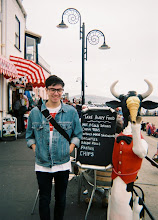
I took the pheasants outside and hung them against plainer and flatter backgrounds. In the image below I hung the pheasants on a corner of the shed and included the trees in as well so as to further connect with my previous images of flora. The image bears some resemblance to Renaissance still-life paintings in which dead animals or more simply 'meat' were a symbol of wealth and distinction. The pheasants plumage is also particularly striking in an image, though the colours are somewhat muted in this particular photograph.
 The images with which I most associate the depiction of pheasants with, however, are not historical paintings of the landed gentry and their landscapes but instead the work of a photographer called Richard Learoyd. His image below struck me, as well as his method of working being particularly interesting, in that he uses a walk-in camera obscura, which I will discuss in a later post.
The images with which I most associate the depiction of pheasants with, however, are not historical paintings of the landed gentry and their landscapes but instead the work of a photographer called Richard Learoyd. His image below struck me, as well as his method of working being particularly interesting, in that he uses a walk-in camera obscura, which I will discuss in a later post.

I also took further pictures against plain backgrounds, hanging the pheasants from a clothes-line pole, this did give me a more empty background and allowed the colours to stand out far more effectively but did leave me with images which contained elements I did not want in there, the image below is an example of this. I considered editing out these elements in Photoshop however decided to discard it from my more finalised work as I felt that working in Polaroid film requires un-tampered with pictorial reality and the results of my Photoshopping would not be visible on the original image anyway. I believe there is an intrinsic link between Polaroid and the 'Truth', however subjective it may be. This edited image is furthest below.



No comments:
Post a Comment